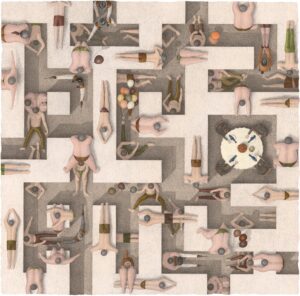The Library of Alexandria was Alexander the Great’s vision to gather all information in the world, under one roof. He had Aristotle himself, the father of logic, as his teacher, and he knew that if you want good logic you have to have good information. Therefore, Alexander wanted to gather all the information in the whole world, under one roof.
Unfortunately, Alexander died quite early in Babylonia, and it was his general Ptolemy, who took over Egypt, who erected the edifice in his honour. Ptolemy’s grandson, Ptolemy III, introduced a law that all information entering the country had to be copied, the copy was sent back, and the original was stored in the library. At the same time, separate ships were also sent out to collect information from all over the Mediterranean. Eventually, therefore, the library became the largest collection of information in the world.
The information allowed Eratosthenes, who was the chief librarian at the time, to calculate the circumference of the earth, 200 years before Christ. Yet there are still people who believe that the earth is flat to this day. One of them was Mad Mike Hughes, who in 2020 shot himself up in a homemade rocket to check for himself. this is completely in line with the scientific method, which was created here in Egypt a millennium ago. The method includes a hypothesis, an experiment and then an observation, .
However, the hypothesis that the Earth is flat has been disproved previously by countless experiments and observations. But he didn’t trust them and wanted to check for himself. Unfortunately for him, the rocket launch was a failure and he spiralled down to his death. But one should not hold it against him. There have been plenty of rocket launches that ended in failure. He must, however, have known so much correct knowledge to even gain buoyancy. Much more than the average citizen will ever acquire. Yet he was wrong about something so basic. It should say something about our own perception of reality, both at the societal and individual level. That there may be established truths, which do not correspond to reality. Even Einstein did not believe in quantum physics’ uncertainty principle, because it spoke against his own model of the universe. In fact, it turns out that the smarter you are, the easier it is for you to twist information to fit your worldview.
The most crucial event for our understanding of the world and the universe is the development of the scientific method, which came into being, precisely here in Egypt, just over a thousand years ago. The Arab Ibn Al-Haytham, considered to be the foremost mathematician of the day, had boasted that he could dam the Nile. But when he came down and saw the massive river was at least three times the size he had imagined, he quickly realized that the task was impossible. So, he pretended to go insane, i.e. that his brain was giving him the wrong information, to avoid being beheaded. As the king was in the habit of dealing with those he didn’t like. Instead, he was put under house arrest, and it was when he sat there, locked in a pitch-dark room, that he discovered something astonishing. There was a small hole in the wall, and at certain times of the day light poured in through the hole and projected the world outside, upside down on the wall! This was the first observed Camera Obsura that we know of, and Al-Haytham understood that this showed how light travels in a straight line.
When Al-Haytham, after the king’s death, came out of captivity, he began to write one of the most influential books in the history of science, which in English goes by the name; Optics. The special thing about this book was that it presented the scientific method, with a hypothesis, an experiment and an observation. The method laid the foundation for modern science and the book has, among other things, found its way to Galileo, Copernicus and Newton’s bookshelves, and allows us to have successful rocket launches to this day.
However, not all information that are presented as facts, necessarily is. The media, with newspapers, television and now the internet, spreads information to the masses. But this can unfortunately be manipulated, as when the Nazis set fire to the Reichstag and blamed the socialists and communists, and then threw them out of the Reichstag and came to power themselves. A so-called “Black flag” operation, which we have seen several times throughout history. The black flag, also called ISIS, currently manipulates vulnerable individuals through YouTube and twitter, where they post carefully thought-out videos intended to create sympathy for their cause and recruit fighters for their “holy” war. But it’s not just terrorist organizations that manipulate the masses on social media. So have former U.S. presidents. He established fake news, as a concept, to dismiss information that didn’t fit his narrative. His supporters saw him as their only true source of information, ultimately culminating in the storming of Congress on January 6, 2021.
But it’s not just people who operate in our new media landscape. In 2016, Microsoft launched its AI “Tay” on tweeter. The goal was for it to understand and mimic the language of a 19-year-old. However, Tay was taken down less than 24 hours after launch as a result of it starting to post far right and offensive tweets. Chat GTP, which took the world by storm last autumn, today writes news articles and speeches for prime ministers, but the problem is that it doesn’t necessarily care about what is true. Its worldview depends entirely on the information it has been fed by its developers. And that’s also true for our own brains. That is why it is so incredibly important that the information we consume is of the highest possible quality and that we are always critical of it and our own worldview. So that we avoid storming a Congress or launching ourselves into space in a homemade rocket. But then the question becomes: Can you trust everything we’ve told you now? And can you trust yourself and your own abilities to know what sources to trust, and your own ability to interpret that information appropriately?









Reviews
There are no reviews yet.